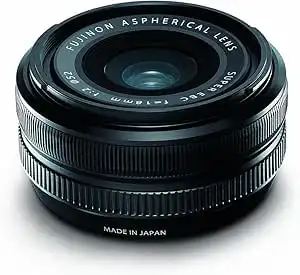The Fujifilm XF 18mm f/2 R stands as one of the inaugural lenses for the X-mount system, and over a decade since its release, it continues to hold a unique and valued place in the lineup. As a compact "pancake" prime, its design philosophy prioritizes portability and discretion above all else. Offering a full-frame equivalent focal length of 27mm, it provides a classic wide-angle perspective that is versatile for a broad range of photographic disciplines. While newer lenses in Fujifilm's stable may offer superior optical perfection and cutting-edge technology, the XF 18mm f/2 R delivers a compelling combination of size, speed, and character that ensures its continued relevance for a specific type of photographer.
In terms of build and handling, the lens is an exercise in minimalism. Weighing a mere 116 grams, its presence on a camera body is almost negligible, making it an ideal companion for smaller Fujifilm cameras like the X-E or X-Pro series. This featherlight construction transforms a camera into a true walk-around, everyday tool that can be easily slipped into a jacket pocket. The lens features a dedicated aperture ring with tactile, one-third-stop clicks, a hallmark of Fujifilm's R-designated lenses that provides direct, manual control over exposure. While the construction incorporates both metal and high-quality plastics, it feels well-assembled and durable enough for its intended use. It is not, however, weather-sealed, which is a consideration for photographers who frequently shoot in adverse conditions. The included square-shaped, vented metal lens hood is a distinct feature, adding a touch of retro styling while effectively shielding the front element from stray light.
The autofocus system is perhaps the most telling indicator of the lens's age. It utilizes a DC coreless motor that, while effective, is neither the fastest nor the quietest by modern standards. The autofocus mechanism involves an external focusing design, meaning the entire optical assembly moves back and forth. This movement is audible, producing a distinct whirring or "buzzy" sound during operation. In good light, focus acquisition is generally swift and accurate enough for static or slow-moving subjects. However, in low-light situations or when tracking subjects, it can struggle, and the focusing speed is noticeably slower than lenses equipped with more contemporary linear motors. For its primary applications in street and documentary photography, the autofocus is perfectly serviceable, but it is not engineered for demanding action or fast-paced scenarios.
Optically, the XF 18mm f/2 R is a lens of compromises, trading some corner-to-corner perfection for its incredibly compact form factor. Center sharpness is quite good, even when shooting wide open at f/2, and it becomes impressively sharp by f/4. This allows for excellent subject isolation and detail rendering in the central part of the frame. The primary optical trade-off is in the corners. At f/2, the edges of the frame are noticeably soft, a characteristic that improves significantly as the lens is stopped down. For optimal sharpness across the entire frame, such as in landscape photography, shooting between f/5.6 and f/8 is recommended.
The lens construction includes two aspherical elements which help manage optical aberrations. Barrel distortion is present in uncorrected RAW files, as is expected from a wide-angle lens, but Fujifilm's excellent in-camera processing corrects this effectively in JPEGs and for RAW developers that apply the embedded lens profile. Vignetting is also apparent at f/2, creating a natural darkening at the corners, though this also lessens upon stopping down and is easily corrected in post-processing. Chromatic aberration is generally well-controlled. With a minimum focusing distance of just 0.18 meters, the lens allows for compelling close-up shots, and the f/2 aperture can produce a pleasing degree of background blur for subjects at this range. The seven-bladed diaphragm creates reasonably smooth bokeh, contributing to the lens’s overall characterful rendering.
The true strength of the Fujifilm XF 18mm f/2 R lies in its intended use cases. For street, travel, and everyday documentary photography, it is an exceptional tool. Its unobtrusive size allows photographers to blend into their environment, capturing candid moments without drawing attention. The 27mm equivalent focal length is wide enough to capture subjects within their context but not so wide as to introduce extreme distortion, making it a highly versatile perspective for cityscapes, environmental portraits, and general storytelling. For landscape photographers who prioritize a lightweight kit for hiking, it is a viable option, provided they are willing to stop down to optimize corner sharpness. It is less suited for architecture, where pristine edge-to-edge performance is critical, or for action sports, where its autofocus would be a limiting factor.
In conclusion, the Fujifilm XF 18mm f/2 R is a lens that should be judged on its design intent rather than on pure technical benchmarks. It is not the sharpest or fastest lens in the Fujifilm XF lineup. Its autofocus motor is dated, and it exhibits noticeable corner softness at its maximum aperture. However, its exceptional compactness, light weight, and useful f/2 aperture create a shooting experience that is both liberating and inspiring. It encourages you to carry your camera everywhere, making it a powerful tool for capturing the world around you. For photographers who value portability and a classic wide-angle view over clinical perfection, the XF 18mm f/2 R remains a characterful and highly compelling choice.
